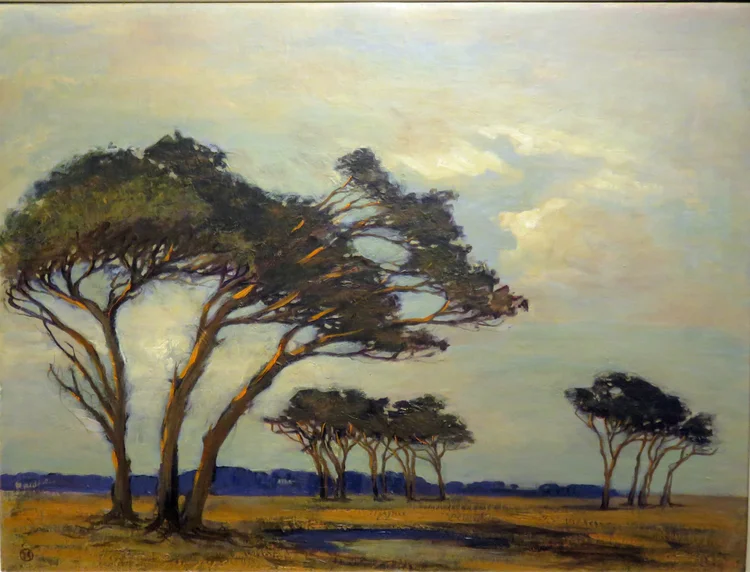The Road Through the Valley, Oil on panel, 17.5 x 25 cm
This is a story, essentially, of one painting, but since the subject of the painting was one of Nita's constant themes ( a winding road through a valley, with trees in the foreground, and a mountain in the background) it is also the story of a collection of related paintings of the artist.
"The Road through the Valley" was auctioned through Stephan Welz and Co on 03/11/1976, and I have absolutely no idea who now owns the painting. But there is a clue: The University of Pretoria embarked on an ambitious survey of South African art in the 1970's, and, within this survey, registered details of the Nita Spilhaus paintings they were able to uncover. Naturally, most of these were in the Pretoria area, and this survey notes the then owner of the painting in August 1978 as J van Proosdij.
Frieda Harmsen was an academic in the Fine Arts Department of the University of South Africa in the 1970's. She was the author of a book entitled "Looking at South African Art". Clearly she chose to focus on paintings that she could actually view in the Johannesburg/Pretoria area and she devoted a detailed structural analysis to Nita Spilhaus's oil painting, "The Road through the Valley", which analysis she supported by detailed diagrams :
It is the line and rhythm of line, as depicted in the linear pattern of diagram 1, that holds the composition together. Nita creates an illusion of space or depth through linear perspective: the converging diagonal line from right to left , defining the dirt road in the painting. She uses painted lines “… made up of strokes, changing direction after minute distances, sometimes at a sharp angle, sometimes curved. With this device she creates a nervous sensitivity and an agitated effect to which the viewer responds subjectively.” The lines in the trees are” agitated”, while in the sky the lines express “turbulence”. To a large extent these lines of composition are intuitively applied by the artist, and are personal and distinctive, such that the expert can base attributions on line.
The grouping and placing of shades (diagram 2) within the overall format contribute to the impact the picture has on the viewer. The two clumps of bushes, the shadows, and the patches of earth balance each other, and contrast the simpler shape of the mountain. The white, grey and blue area of the sky echo the pattern of the trees. The irregular shapes, placed on the panel, evoke loneliness and foreboding. Nita uses light and shade to create this atmosphere. She combines colour with texture (thickness/thinness of paint) to give a sense of depth to the picture, and the combination of the dark colours, contrasted by pure white, pale ochre and a luminous brown, evoke the sense of melancholy. The paint application is clearly visible as is the brush stroke and smear of the palette knife, and contribute to the visual interest of the picture.
------------------------
Such was Frieda Harmsen's analysis. But Nita applied these techniques, both of composition, and mood, to at least four other paintings (two of which are in known private hands, and the other two were auctioned over the past few decades). , In these paintings Nita focussed on the same motif, a lonely road winding through the valley, edged with trees, with a mountain looming in the background:



